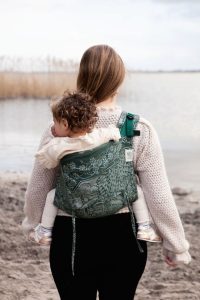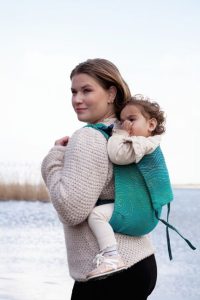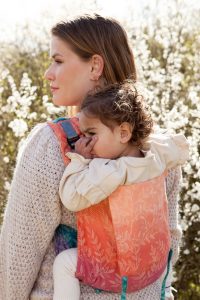How to hold a toddler? Toddlers are bundles of energy, constantly on the move and exploring the world around them. There are times, however, when they need the comfort and security of being held close. This can be for cuddles, for calming down after a tantrum, or simply because they want to be near you.
Holding a toddler correctly is important for both their safety and comfort, as well as for yours. Here’s a guide to different ways to hold your little one, ensuring a secure and loving embrace.
Safety First: Important Tips for Holding Your Toddler
Always prioritize your toddler’s safety when picking them up and holding them. Here are some key things to remember:
Support the head and neck.
Toddlers’ head and neck muscles are still developing, so it’s crucial to provide proper support whenever you pick them up. Cradle their head with one hand while securing their body with the other arm.
Be mindful of your back.
Toddlers can be surprisingly heavy, so proper lifting technique is important to avoid back strain. Bend at your knees and lift with your legs, not your back.
Keep a firm grip.
Even calm toddlers can wiggle unexpectedly. Maintain a firm but gentle hold to prevent them from slipping or falling.
Close Comfort: Different Holds for Different Needs
There are many ways to hold a toddler, each offering comfort and security in different situations. Here are a few common holding techniques:
-
The Cradle Hold: This is a classic hold for newborns and young babies, but it can still be comforting for toddlers. Cradle your toddler in your arms, supporting their head and neck with one hand and their bottom with the other.
-
The Hip Hold: This hold is great for toddlers who are starting to walk. Place one arm around your toddler’s waist and support their legs with your other arm. This position allows them to see the world around them while still feeling secure.
-
The Piggyback Ride: This fun hold is perfect for when your toddler needs a break from walking. Let your toddler climb onto your back and hold onto your shoulders for stability. Make sure you bend slightly at the knees to provide a sturdy base.
-
The Shoulder Hold: This hold is useful for calming down a fussy toddler. Drape your toddler over your shoulder, supporting their head and back with one arm and gently patting their bottom with the other. The rhythmic motion can be soothing.
-
The Lap Hold: This is a cozy hold for cuddling or reading together. Seat your toddler on your lap facing you, with their arms around your neck and your arms wrapped around them.
Reading Your Toddler’s Cues: When to Hold and When to Let Go
Toddlers are constantly communicating their needs through body language and verbal cues. Here are some signs your toddler might want to be held:
- Crying or fussiness
- Clinging to your legs
- Reaching out their arms
- Whining or whimpering
Pay attention to your toddler’s cues and respond accordingly. Sometimes, a hug or cuddle can be the best way to address their needs.
However, there are also times when toddlers need space to explore and be independent. Here are some signs your toddler might want to be put down:
- Becoming stiff or trying to push away
- Arching their back
- Reaching for toys or distractions
- Fussing to be put down
Trust your instincts and follow your toddler’s lead. There will be times for holding close and times for letting go.
The Joy of Connection: Building a Bond Through Holding
Holding your toddler is more than just a physical act; it’s a way to build a strong emotional bond. Cuddling releases oxytocin, a hormone that promotes feelings of love and trust. When you hold your toddler close, you’re communicating love, security, and comfort.
These positive experiences in early childhood can have a lasting impact on your toddler’s emotional development. So go ahead, pick up your little one, hold them close, and enjoy the special connection that comes with simply being together.

Making Memories: The Special Moments of Holding Your Toddler
There are many ways to hold a toddler, each offering comfort and security in different situations. Here are a few common holding techniques:
-
The Peek-A-Boo Hold: This playful hold is a fun way to interact with your toddler. Hold your toddler facing away from you, with their arms around your neck. Peek over your shoulder and say “peek-a-boo!” This can bring smiles and giggles.
-
The Facing Forward Hold: This hold is great for when you want to explore together. Hold your toddler facing forward, with one arm supporting their chest and the other supporting their thighs. This position allows them to see the world around them while staying close to you.
-
The Walking Hold: This hold is useful for toddlers who are starting to walk but need a little extra help with balance. Stand behind your toddler and hold their hands, gently guiding them as they walk. This can build their confidence and coordination.
-
The Dancing Hold: Turn up the music and have some fun! Hold your toddler close, with one hand on their back and the other supporting their hips. Sway to the music and sing along. This is a great way to bond and create happy memories.
-
The Snuggle Hold: Sometimes, all your toddler needs is a cozy cuddle. Curl up on the couch or in a comfy chair, and hold your toddler close. Read them a story, sing them a lullaby, or simply enjoy the quiet closeness.
Safety Reminders: Always a Priority
No matter how you hold your toddler, safety is always the most important thing. Here are some quick reminders:
- Keep a firm but gentle grip to prevent them from slipping or falling.
- Be mindful of your back. Bend at your knees and lift with your legs to avoid strain.
- Always supervise your toddler closely, especially when they are in a new or unfamiliar environment.
The Gift of Holding: Building a Strong Bond
Holding your toddler is more than just a physical act; it’s a way to build a strong emotional bond. Physical closeness releases oxytocin, a hormone that promotes feelings of love and trust. When you hold your toddler close, you’re communicating love, security, and comfort.
These positive experiences in early childhood can have a lasting impact on your toddler’s emotional development. So go ahead, pick up your little one, hold them close, and enjoy the special moments that come with simply being together.




